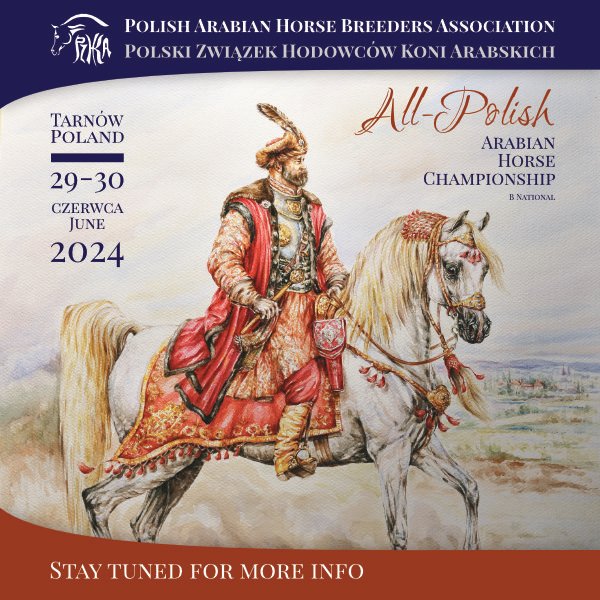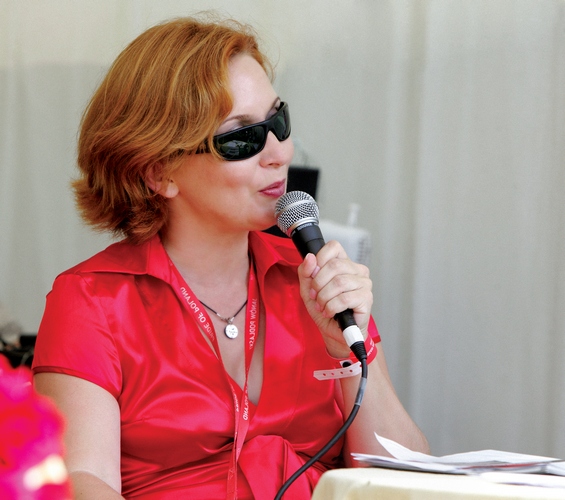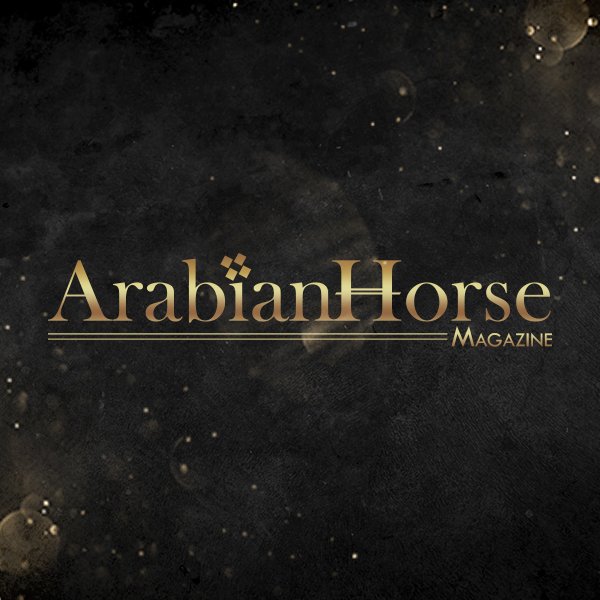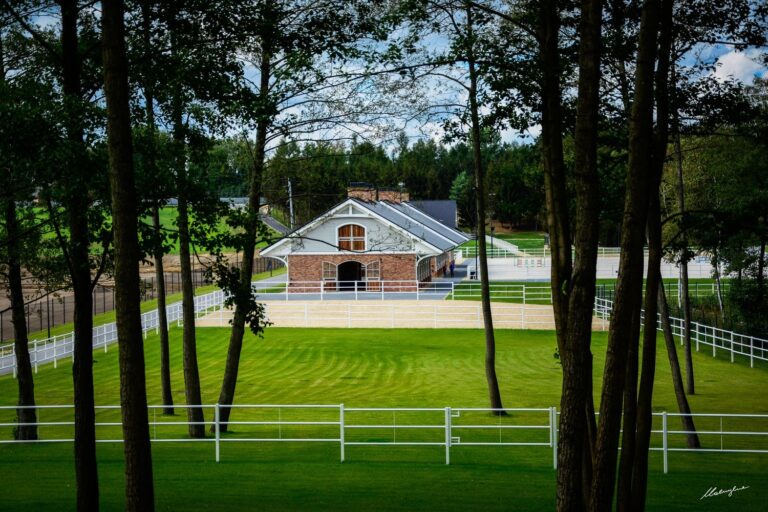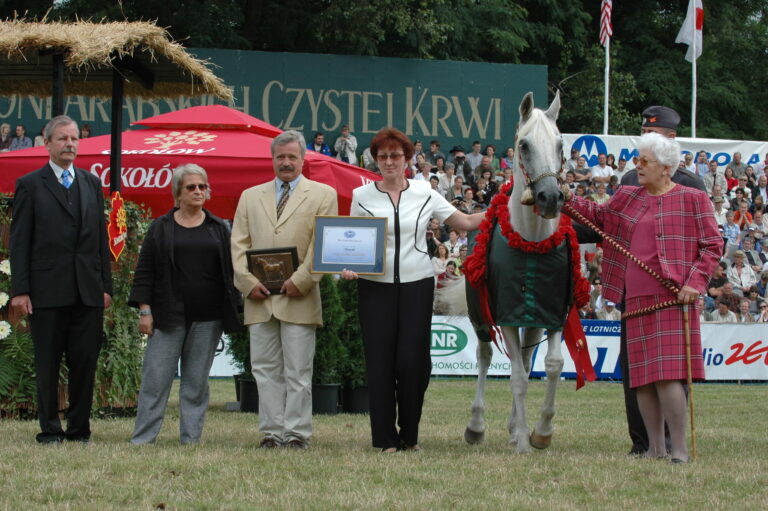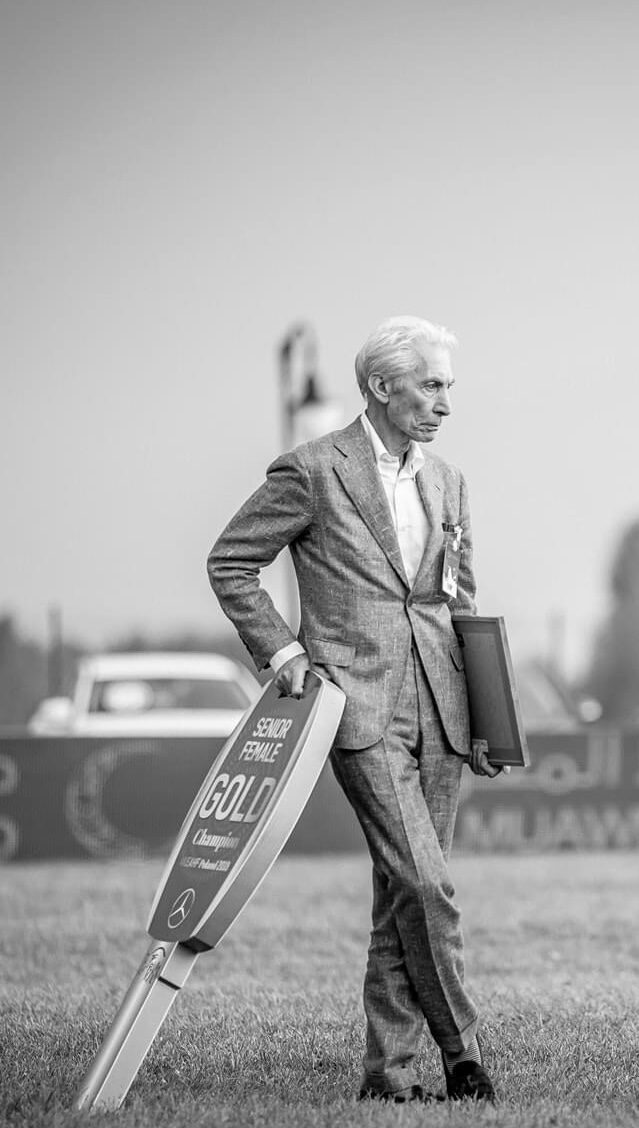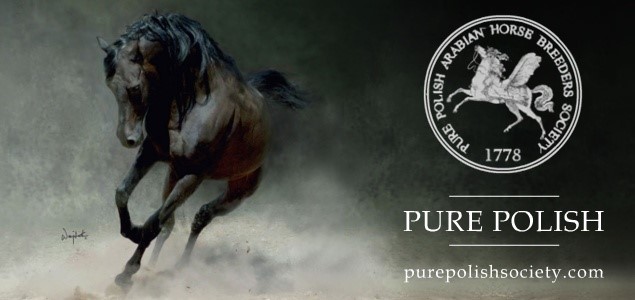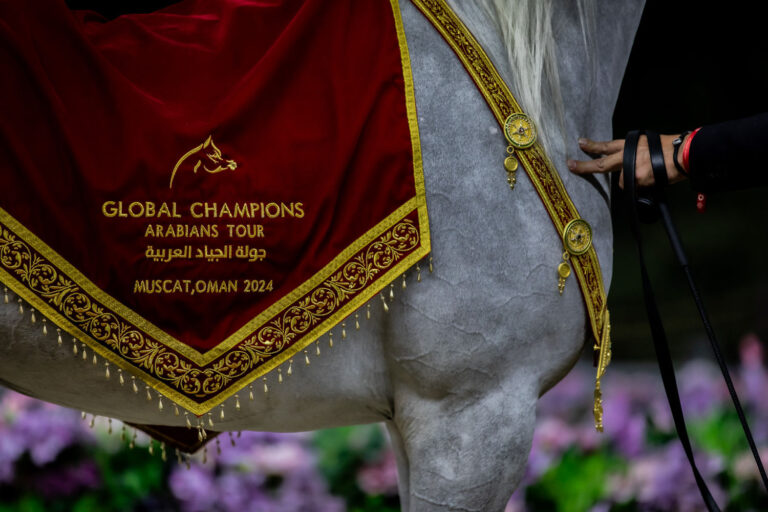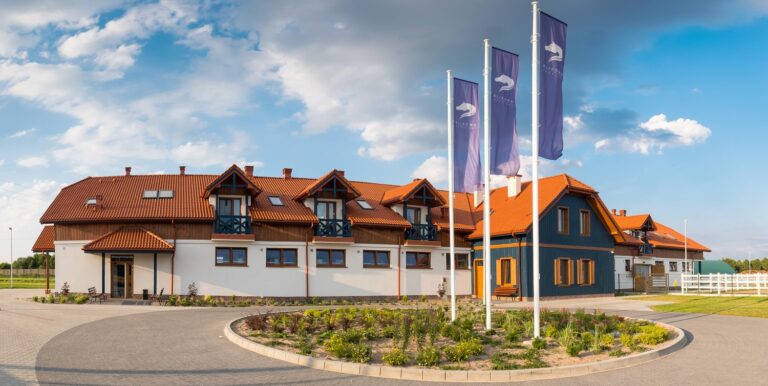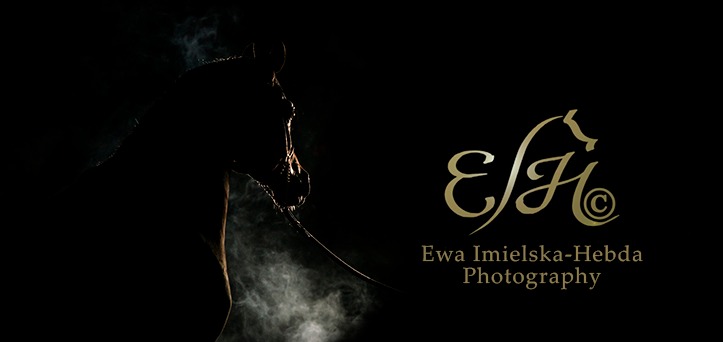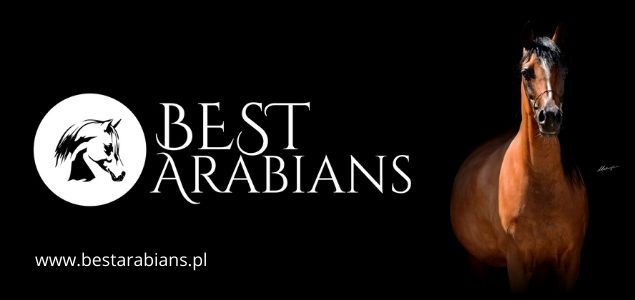Monika Luft: How do you rate the January performance of the Polish horses at the Al Khalediah Show in Saudi Arabia?
Anna Stojanowska: For horses from Poland, or any horses from our part of Europe, it is a risky journey due to the climate shock. They have to be clipped, whereas our country is cold. For the breeders it is a difficult time, as we have the beginning of the breeding season. That’s why Polish horses didn’t really appear at the Middle Eastern shows. This is the first such numerous – as many as 5 Polish-bred horses! – trip in that direction. And it’s a good thing, too, because usually the confrontation of our horses with others takes place only at European shows. As we can see, they can not only make an attempt at winning, but also come out victorious also in the Middle East!
M.L.: Lately we were worried that the large pressure from the Middle Eastern breeders and owners on the promotion of Egyptian type horses might be a threat to the popularity of our breeding. And still the Polish horses stand their ground.
A.S.: The expansion of the Egyptian lines is strong, because huge finances drive it. It is true that the beauty traits which play such a strong role at the shows, are more strongly solidified in horses of the Egyptian type. On the other hand, no one ever cared about a correct conformation or stamina in the case of these lines. A couple of years ago there were some very serious notions presented on the ECAHO forum to omit the leg evaluations at the shows, as they are not really necessary. Poland was then the main opponent of that idea. What point is there in a car without wheels? In such case those that claim that the Arabian is merely a porcelain doll, a horse of no use: pretty and nothing else, would be right.
M.L.: We are just prior to the breeding season. In what direction, in your opinion, will the breeding of Arabian horses in Poland go?
A.S.: I have no idea! Just six, seven years ago, 350 Arabian mares were registered. The majority was the property of the State Studs. Today there are almost 1000 mares, while the number of them in the State Studs remains the same. As much as it was easy to speak of a consolidated breeding program or one breeding direction in the case of those 350 mares, those 650 are a complete unknown, because every owner has his own vision. I think that trends have a large influence on the direction of breeding. Breeders attend shows, observe which horses are winning, by which sires. Many of them have unlimited financial resources and can use that which is most trendy in the given season. Sires used in Poland come not only from Europe, but also from the US and other continents. On the other hand, there are breeders which are clearly orientated on a racing or endurance program. Success can be achieved the fastest at the races, because there isn’t so much competition from the State Studs and the test comes rather fast – Arabians debut at the track at the age of 3. I hope that each one finds his own niche, in which he will be able to realize himself. Not everyone has to wait for a second Pianissima. If someone has pleasure from dealing with an Arabian horse, he can have a foal each year that will make him proud. That’s what performance (under saddle) classes are for – here the bond between the horse and rider counts and we don’t need a highly paid trainer to achieve success. A true, personal bond between you and the horse is what really counts.
M.L.: We have over 160 breeding stallions. Should this be the case?
A.S.: I think it shouldn’t. But the regulations in the breeding act are quite straightforward about it. Each foal born from Arabian parents is registered directly in the stud book, unlike in the case of part breds, where the foal is only registered in the stud book under the dam, but has to qualify to earn his own registration. At the Arabian association meetings there were attempts at establishing licenses, but so far without any result. And so the use of a horse in breeding depends only on the decision of the breeder. The awareness of the breeder is very important. The State Studs abide by the rule that a stallion, before he breeds, must undergo a trial at the racetrack or at the shows (although he doesn’t need to win), have a correct conformation and be of Arabian type, but in private breeding we can’t enforce the respecting of these rules. If somebody decides to use his favorite stallion, nobody can forbid it.
M.L.: It seems that the rivalry which the private breeders have uptaken against the State Studs, will deepen.
A.S.: The disproportion, which just a couple of years ago was clearly visible, has now much decreased. However the private breeders are still rather inferior in terms of conditioning and logistics. If a private bred horse wins one or two shows, he is highly exploited until the end of the season. As a result the horse will be bored, tired, with a couple of thousand kilometers spent in the horsetrailer and… will eventually start to lose. Besides that, there are still too few professional training centers in Poland. The State Studs have this advantage that they count on experienced staff– although not as many as once. Because it is not just a matter of show training, but conditioning, clipping, make-up… It is a whole knowledge, which cannot be learnt just like that.
M.L.: Do the State Studs have – and should they have – their own secrets? For example the usage of certain stallions. Eryks, who won the Autumn Championships in Janów Podlaski, was held nearly until the end of the breeding season „in secrecy”.
A.S.: In state companies everything must be done transparently – nearly everyone can take a look at every document. We opened the breeding inspections (which once were closed events) to allow private breeders to take a look and draw conclusions. Eryks also wasn’t „hidden” anywhere. It is quite often with young horses that after returning from the track they have to switch to a different biological mode. The mares can have a difficulty to get into heat, the stallions with their libido. They need time to stabilize their hormonal balance. Arabian horses mature rather late, that’s why we let them rest during the first season. That was the case with Eryks. Because there was no urgent need to breed him at once, he was left to rest. When he matured and became masculine – the time to show him came.
M.L.: What do you think about breeding 2 year old stallions to 3 year old mares? This practice is becoming more and more common across the world.
A.S.: It is assumed that a horse is ready to reproduce after turning 36 months of age. A 3 year old mare is physiologically ready to be bred. Of course we can say it is the same as with a 15 year old girl. Physically she is mature, but mentally – absolutely not. However there is no proof that covering a 3 year old mare has a negative effect on her health. A different issue is that the Egyptian type horses mature earlier due to the climate and genes. However I thought that the usage of the 1,5 year old Marwan Al Shaqab (something which caused much talk among the Arabian world) was going too far.
M.L.: The encouraging effects of his usage gave others courage to also start breeding their colts at an early age.
A.S.: We hear about Marwan Al Shaqab or QR Marc, but they are still singular cases in the entire Arabian horse population. It seems that in the overall reckoning common sense wins. Besides, Marwan developed normally, it doesn’t seem to have hurt him. Although I still believe that the rules are there to abide them. We have long discussed whether to incorporate the junior colts classes into the National Show. The opinions were divided. Director Marek Trela was against it – he deemed the incorporation of the junior colts into the Polish Nationals as a necessary evil. I understand his reasons, though I voted for: after the Spring Show in Białka the yearlings and two year olds should spend time out on the pastures, because it is the best time for them to correctly develop. This concerns the future sires, the elite! Meanwhile, instead of roaming the fields, they are conditioned to perform at the championships.
M.L.: Then how come the Polish stallions don’t breakthrough to the world elite?
A.S.: That was once, today the situation is changing. One of the main reasons was purely technical: the ease of access. The Western part of the world has been freezing semen for years and the usage of nearly every stallion was unlimited – take for example Kubinec, who covered perhaps tens of thousands of mares in Europe alone. Meantime, to breed to a Polish stallion, a foreign breeder had to transport his mare here, which was complicated and expensive. When we were not yet in the European Union, shipping semen from the country was an ordeal – ATA carnets and tons of veterinary certificates! No foreign businessmen wanted to go through all that. Similar barriers existed during attempts at organizing an international show. Coming to a country somewhere in the East, with roads of questionable quality and with this amount of paperwork, was unimaginable. In the last years, when first Łąck and later Michałów began freezing semen, the usage of Polish stallions abroad clearly increased. Of course Ekstern is beyond reach, renown across the world and promoted. But other stallions are also enjoying huge interest.
M.L.: What was the root of the groundbreaking concept (in comparison to what the Agricultural Property Agency has been executing so far), which is a return of the breeding fee in case the mare should prove barren?
A.S.: Groundbreaking is perhaps bit over the top. Rather the common ground of mutual understanding and cooperation between the private breeders and the state sector keeps on constantly evolving. For studs, which have a numerous group of horses to keep, and where human resources have decreased nearly to an absolute minimum (there are never too many people to work around horses), accepting additional mares for covering during the breeding season was a serious burden, consuming space and human labor. That’s why the fees for breeding (set according to norms in other European countries) did not encourage or weren’t especially promotional for Polish breeders. Together with the development of insemination, a wider access to semen, both fresh and frozen, as well as the services (the insemination itself), most breeders order a sire in a straw with home delivery. The problem of a lack of space in the studs ceased to exist. However we must not forget that the efficiency of insemination, especially with frozen semen, is lower than in the case of natural breeding. We are also all well aware of the extremely high costs of the services connected with the insemination (the cost of the veterinarian, testing etc.). It is easier to take a risk, both financially and mentally when it concerns an efficient process, ending successfully. Thus the decision about returning the fee if the mare should not be in foal.
M.L.: When will Poland start performing embryotransfer?
A.S.: Not soon, although it is unavoidable. It is a very expensive process – we should ask if it’s worth it. If the horse is bred for the fun of it and money isn’t an issue, then you can afford to produce a foal for the sum of 50 thousand USD, as is the case in the US. Embryotransfers are a good solution when we don’t want to exclude the mare from the show cycle. In Poland it is for now a rather distant future.
M.L.: But when you can obtain 4, 5 or 6 valuable foals in one season, then it could start being affordable.
A.S.: In Poland the stud book regulations do not allow for the registration of foals from embryotransfer. We do not plan to change them for now.
M.L.: A problem of the Polish market is the over-production of horses – geldings, horses of lesser quality – with no concept on how to use them. What to do with them?
A.S.: Nobody knows what. An over-production of horses is not just a Polish problem. There is always a demand for the best, but these are only 10% of the entire population, while breeding is made by the horses of the middle and the far end. Because a horse has no longer other uses than recreational, only the popularization of Arabians as horses suitable for sports or family riding horses can do something to help. Though an Arabian is a luxury item and there is always limited demand for him. Luckily some of the horses are exported abroad. The studs also sell stallions to the circus – the circusmen claim that Arabians are good to work with.
M.L.: How far should the Janów Sale open for horses of private breeding?
A.S.: In my opinion, at least for now, it should be open just as it was, which is 10-15% of the offer, for a couple of reasons. That which draws the buyers is the brand of the State Studs. We all benefit from this, private breeders also. The second factor is the necessity of maintaining a standard of the auction. They have to be elite horses, and an elite cannot be numerous. 20, 30 horses – but not a hundred. The selection is extremely strict. And although sometimes the private bred horses aren’t worse than those of the State Studs, still even the weaker state horses sell for higher prices than the best private. The offer is constructed that three, four horses – the absolute „cream of the crop” that the clients will fight over – “upgrade” the rest. Another reason is of an organizational matter: a horse entered into the sale cannot be withdrawn from it. A client who comes to Janów must be certain that he will not be able to purchase a horse in any other way, even if he had millions stashed in his pockets. The catalogue is put together a long time before the sale and there is no possibility of changing a once up taken decision. It is hard to demand such discipline from a private breeder. If he finds a client, he will withdraw the horse and sell, but on the other hand we shouldn’t be that surprised. The State Studs have worked over 40 years for the trademark of today’s auction. They have endured through the hard times of the recession. We must remember that the high seller of the 1995 auction was sold for $30,000! Today’s boom is the consequence of their persistence. Now the clients are so wound up during the auction that they would even buy the cats from the stables.
M.L.: How many Arabian State Studs should there be in Poland? How much do we lack Kurozwęki?
A.S.: For years breeding in Poland has been trying to avoid a high inbred. With such a small population, as we had until the 90s, four studs provided a geographical diversity. Later the private breeding evolved greatly and it turned out that the existence of four studs is not necessary. Kurozwęki, as is generally known, closed the field, the breeding progress was least visible there. Director Guziuk himself felt that the transfer of Kurozwęki into private hands – the Popiel family – will allow for new investments. Today, with such an amount of mares in Poland, three studs are sufficient to provide a diversified genetic pool. We should note that each stud is specific in its own way – there is a characteristic Janów and Michałów Arabian. Białka, as the youngest stud, established from mares given by other studs, is the least leveled in terms of genetics and is the greatest unknown when it comes to selecting stallions. Ekstern is doing a good job there – he is especially useful when type needs to be upgraded.
M.L.: What should we wish for this season? We already have (another) World Champion…
A.S.: For me success means the maintaining of this level. Though we are at the top, we cannot allow for the commotion around our horses to settle down. Because everything else follows it. There would be no success of the Janów sale if the Polish Arabians would not be shown at the world arenas. That is the best promotion. As experience shows, only Pure Pulish can compete with the horses from the Middle East. Neither the American, Spanish nor Russian horses stand the competition. In the conversations with the stud directors I often hear: ah, Kwestura, we would want her to foal something even better… But that is very difficult! Or Pianissima. What better than herself can she give? May it not be worse! Very beautiful fillies always have a tougher mission, because the expectations are very high. We are proud when we are able to get a pretty foal from an ugly dam. In the case of Pianissima, every comparison will be to the disadvantage of her offspring.
M.L.: What is the concept for your own horses?
A.S.: I keep horses only for pleasure. A couple of years ago I bought a mare eliminated from breeding in Michałów, with an interesting pedigree. With my type of work, a lot of paperwork, I wanted to be in touch with a real horse and a breeding reality. I had a couple of foals, but to have results, you have to really take care of the horse, not just when you have a spare moment. Perhaps I lack ambition… though I know that it is a pleasure to receive trophies! For me just being with the horses is enough. Yes, I entered my colt by Ecaho twice, but because he is standing at a livery stable and nobody has time to train him, so eventually I gave it a rest.
M.L.: You travel a lot, also as a judge. Is every such journey inspiring?
A.S.: Definitely, though I sometimes wonder when this will start boring me. I work for five days in the week, judge shows during weekends. And I have a small child, who sometimes forgets who his mother is. All this is a rather large sacrifice for me. On the other hand, when I’m standing on the arena and wait for the first horses to enter, I get goose bumps every time. Like a young girl.


